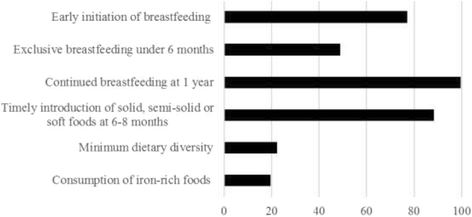Situation and determinants of the infant and young child feeding (IYCF) indicators in Madagascar: analysis of the 2009 Demographic and Health Survey
- PMID: 29037229
- PMCID: PMC5644246
- DOI: 10.1186/s12889-017-4835-1
Situation and determinants of the infant and young child feeding (IYCF) indicators in Madagascar: analysis of the 2009 Demographic and Health Survey
Abstract
Background: Studies evaluating child feeding in Madagascar are scarce despite its importance in child growth during the first two years of life. This study assessed the associations between the WHO infant and young child feeding (IYCF) indicators and stunting and identified determinants of inappropriate child feeding practices.
Methods: The most recent Demographic and Health Survey was used including a total of 1956 infants aged 0-23 months. Logistic regressions were performed for the association between IYCF indicators and stunting and for the determination of risk factors for inappropriate feeding practices.
Results: The rates of initiation of breastfeeding within one hour after birth (77.2%), continued breastfeeding at one year (99.6%) and timely introduction of solid, semi-solid or soft foods at 6-8 months (88.3%) were high. Exclusive breastfeeding under 6 months (48.8%), attaining minimum dietary diversity (22.2%) and consumption of iron-rich foods (19.6%) were relatively low. Higher length-for-age was associated with achieving minimum dietary diversity (p<0.01). The other indicators assessed (early initiation of breastfeeding, exclusive breastfeeding under 6 months, timely introduction of complementary foods and consumption of iron-rich foods) were not associated with stunting. Infants born to mothers who had first given birth at an age younger than 19 were more likely not to be breastfed within one hour after birth, not to be exclusively breastfed and not to have the recommended dietary diversity. Infants whose mothers had low media exposure were at increased risk of being inappropriately fed. Low household wealth also was associated with higher odds of not meeting the minimum dietary diversity.
Conclusions: Despite almost total continued breastfeeding at one year and early initiation of breastfeeding by more than three-quarter of mothers, minimum dietary diversity scores were still low, confirming the need for more effective programs for improving child feeding practices in Madagascar. Improving dietary diversity in children aged 6-23 months may help reduce stunting. The identified risk factors for inappropriate feeding practices could be used in directing future nutrition sensitive interventions.
Keywords: Child feeding; IYCF indicators; Madagascar; Stunting.
Conflict of interest statement
Ethics approval and consent to participate
Not applicable.
Consent for publication
Not applicable.
Competing interests
The authors declare that they have no competing interests.
Publisher’s Note
Springer Nature remains neutral with regard to jurisdictional claims in published maps and institutional affiliations.
Figures
Similar articles
-
Maternal determinants of optimal breastfeeding and complementary feeding and their association with child undernutrition in Malawi (2015-2016).BMC Public Health. 2019 Nov 11;19(1):1503. doi: 10.1186/s12889-019-7877-8. BMC Public Health. 2019. PMID: 31711452 Free PMC article.
-
Infant and young child feeding practice status and its determinants in UAE: results from the MISC cohort.Int Breastfeed J. 2025 Jan 21;20(1):6. doi: 10.1186/s13006-024-00685-2. Int Breastfeed J. 2025. PMID: 39838393 Free PMC article.
-
Determinants of infant and young child feeding practices in Bangladesh: secondary data analysis of Demographic and Health Survey 2004.Food Nutr Bull. 2010 Jun;31(2):295-313. doi: 10.1177/156482651003100220. Food Nutr Bull. 2010. PMID: 20707235
-
Nutrition: basis for healthy children and mothers in Bangladesh.J Health Popul Nutr. 2008 Sep;26(3):325-39. doi: 10.3329/jhpn.v26i3.1899. J Health Popul Nutr. 2008. PMID: 18831228 Free PMC article. Review.
-
[WHO growth standards for infants and young children].Arch Pediatr. 2009 Jan;16(1):47-53. doi: 10.1016/j.arcped.2008.10.010. Epub 2008 Nov 25. Arch Pediatr. 2009. PMID: 19036567 Review. French.
Cited by
-
Factors associated with fathers' involvement in infant and young child feeding and nurturing care in the urban slums of Bangladesh: A cross-sectional study.Food Sci Nutr. 2023 May 6;11(7):4020-4029. doi: 10.1002/fsn3.3390. eCollection 2023 Jul. Food Sci Nutr. 2023. PMID: 37457166 Free PMC article.
-
Prevalence of exclusive breastfeeding practice and its association with maternal employment in Ethiopia: a systematic review and meta-analysis.Int Breastfeed J. 2021 Oct 30;16(1):86. doi: 10.1186/s13006-021-00432-x. Int Breastfeed J. 2021. PMID: 34717673 Free PMC article.
-
Dietary diversity of 6- to 59-month-old children in rural areas of Moramanga and Morondava districts, Madagascar.PLoS One. 2018 Jul 13;13(7):e0200235. doi: 10.1371/journal.pone.0200235. eCollection 2018. PLoS One. 2018. PMID: 30005067 Free PMC article.
-
Maternal Knowledge, Attitudes, and Practices of Complementary Feeding and Child Undernutrition in the Vakinankaratra Region of Madagascar: A Mixed-Methods Study.Curr Dev Nutr. 2020 Oct 20;4(11):nzaa162. doi: 10.1093/cdn/nzaa162. eCollection 2020 Nov. Curr Dev Nutr. 2020. PMID: 33274306 Free PMC article.
-
Maternal determinants of optimal breastfeeding and complementary feeding and their association with child undernutrition in Malawi (2015-2016).BMC Public Health. 2019 Nov 11;19(1):1503. doi: 10.1186/s12889-019-7877-8. BMC Public Health. 2019. PMID: 31711452 Free PMC article.
References
-
- WHO . Part. Definitions. Geneva: World Health Organization; 2008. Indicators for assessing infants and young children feeding practices.
-
- Jones AD, Ickes SB, Smith LE, Mbuya MN, Chasekwa B, Heidkamp RA, Menon P, Zongrone AA, Stoltzfus RJ. World Health Organization infant and young child feeding indicators and their associations with child anthropometry: a synthesis of recent findings. Matern Child Nutr. 2014;10(1):1–17. doi: 10.1111/mcn.12070. - DOI - PMC - PubMed
-
- Disha AD, Rawat R, Subandoro A, Menon P. Infant and young child feeding practices in Ethiopia and Zambia and their association with child nutrition: analysis of demographic and health survey data. Afr J Food Agric Nutr Dev. 2012;12(2):5895–5914.
MeSH terms
LinkOut - more resources
Full Text Sources
Other Literature Sources
Medical


